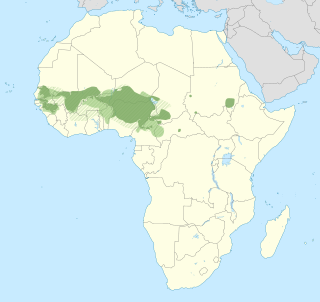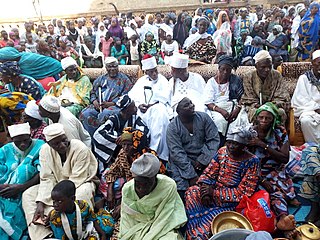
Hausa is a Chadic language that is spoken by the Hausa people in the northern parts of Nigeria, Ghana, Cameroon, Benin and Togo, and the southern parts of Niger, and Chad, with significant minorities in Ivory Coast. A small number of speakers also exist in Sudan.

Niger–Congo is a hypothetical language family spoken over the majority of sub-Saharan Africa. It unites the Mande languages, the Atlantic–Congo languages, and possibly several smaller groups of languages that are difficult to classify. If valid, Niger–Congo would be the world's largest in terms of member languages, the third-largest in terms of speakers, and Africa's largest in terms of geographical area. It is generally considered to be the world's largest language family in terms of the number of distinct languages, just ahead of Austronesian, although this is complicated by the ambiguity about what constitutes a distinct language; the number of named Niger–Congo languages listed by Ethnologue is 1,540.

The Gur languages, also known as Central Gur or Mabia, belong to the Niger–Congo languages. They are spoken in the Sahelian and savanna regions of West Africa, namely: in most areas of Burkina Faso, and in south-central Mali, northeastern Ivory Coast, the northern halves of Ghana and Togo, northwestern Benin, and southwestern Niger. A few Gur languages are spoken in Nigeria. Additionally, a single Gur language, Baatonum, is spoken in Benin and in the extreme northwest of Nigeria. Three other single Gur languages, the Tusya, Vyemo and Tiefo languages, are spoken in Burkina Faso. Another unclassified Gur language, Miyobe, is spoken in Benin and Togo. In addition, Kulango, Loma and Lorhon, are spoken in Ghana, Ivory Coast and Burkina Faso. Additionally, a few Mossi speakers are in Senegal, and speakers of the Dagaare language are also found in Cameroon. The Samu languages of Burkina Faso are Gur languages.

Zarma is one of the Songhay languages. It is the leading indigenous language of the southwestern lobe of the West African nation of Niger, where the Niger River flows and the capital city, Niamey, is located. Zarma is the second-most common language in the country, after Hausa, which is spoken in south-central Niger. With over 6 million speakers, Zarma is easily the most widely spoken Songhay language.

Supyire, or Suppire, is a Senufo language spoken in the Sikasso Region of southeastern Mali and in adjoining regions of Ivory Coast. In their native language, the noun sùpyìré means both "the people" and "the language spoken by the people".

Fula, also known as Fulani or Fulah, is a Senegambian language spoken by around 36.8 million people as a set of various dialects in a continuum that stretches across some 18 countries in West and Central Africa. Along with other related languages such as Serer and Wolof, it belongs to the Atlantic geographic group within Niger–Congo, and more specifically to the Senegambian branch. Unlike most Niger-Congo languages, Fula does not have tones.

Kwara State is a state in Western Nigeria, bordered to the east by Kogi State, to the north by Niger State, and to the south by Ekiti, Osun, and Oyo states, while its western border makes up part of the international border with Benin Republic. Its capital is the city of Ilorin and the state has 16 local government areas.
Kusaal is a Gur language spoken primarily in northern eastern Ghana, and Burkina Faso. It is spoken by about 121,000 people and takes its name from the Kusaal people, or Kusasi. There is a distinctive dialect division between Agole, to the East of the Volta River, and Toende, to the West. Agole has more speakers. The 6-district capital; Bawku West with Zebilla as capital and the rest; Binduri, Bawku, Tempane, Garu and Pusiga districts mostly Agole dialect speakers. The complete Bible translation is in the Agole dialect.

There are over 525 native languages spoken in Nigeria. The official language and most widely spoken lingua franca is English, which was the language of Colonial Nigeria. Nigerian Pidgin – an English-based creole – is spoken by over 60 million people.
Ixcatec is a language spoken by the people of the Mexican village of Santa María Ixcatlan, in the northern part of the state of Oaxaca. The Ixcatec language belongs to the Popolocan branch of the Oto-manguean language family. It is believed to have been the second language to branch off from the others within the Popolocan subgroup, though there is a small debate over the relation it has to them.
Lau (Law) is a Jukunoid language of Lau LGA, Taraba State, Nigeria. Lau speakers claim that their language is mutually intelligible with the Jukunoid language varieties spoken in Kunini, Bandawa, and Jeshi. They also live alongside the Central Sudanic-speaking Laka, who live in Laka ward of Lau LGA.
Busa, or Bisã, is the Mande language of the former Borgu Emirate in northwestern Nigeria and northern Benin. It is called Busanci in Hausa, and has also been called Zugweya.

The Bariba people, self designation Baatonu, are the principal inhabitants of Borgou and Alibori Departments, Benin, and cofounders of the Borgu kingdom of what is now northeast Benin and west-central Nigeria. In Nigeria, they are found spread between western Kwara State and the Borgu section of Niger State. There are perhaps a million Bariba, 70% of them in Benin, where they are the fourth largest ethnic group and comprise approximately 1/11 of the population (9.2%).
Boko, or Boo, is a Mande language of Benin and Nigeria.
Gourmanché is the language of the Gurma people. It is the largest by number of speakers of the Gurma subgroup of the Oti-Volta languages, which includes among others the Moba language and the Konkomba language. It is the major language of the easternmost parts of Burkina Faso, around the traditional Gurma capital Fada N'Gourma; it is also spoken in neighbouring parts of northern Togo, Benin, Niger, Ghana and Nigeria.
The Otoro language is a Heiban language which belongs to the Kordofanian Languages and therefore it is a part of the Niger-Congo Languages. In a smaller view the Otoro is a segment of the „central branch “ from the so-called Koalib-Moro Groupe of the Languages which are spoken in the Nuba Mountains. The Otoro language is spoken within the geographical regions encompassing Kuartal, Zayd and Kauda in Sudan. The precise number of Otoro speakers is unknown, though current evaluates suggest it to be exceeding 17,000 people.

Tammari is a language which is spoken in Benin and Togo. It is also known as Ditammari. The Tammari people, who live in Benin and Togo, mostly speak the language. There are about 47.000 speakers. About half live in Togo, the other half in Benin. Ditammari is one of the Gur languages.
Guosa is a constructed interlanguage originally created by Alex Igbineweka in 1965. It was designed to be a combination of the indigenous languages of Nigeria and to serve as a lingua franca to West Africa.
Borgu Fulfulde, also known as Borgu Fulani, Benin-Togo Fulfulde, Fulbe-Borgu, or Peul is a variety of the Fula language a West Atlantic language part of the Niger-Congo language family, it is spoken primarily in the Borgou Department of Benin, spanning Nigeria, other parts of Benin, as well as Togo and parts of Burkina Faso.
Central-Eastern Niger Fulfulde, also known as Lettugal Niiser Fulfulde is a variety of the Fula language, a Niger–Congo language predominantly spoken in the Central and Eastern regions of Niger, particularly among the Fulani people. The linguistic structure of this language exhibits distinct features, including a Subject-Verb-Object (SVO) word order. Prepositions and postpositions are utilized in the language to convey spatial relationships. Genitives, articles, adjectives, numerals, and relatives follow noun heads, contributing to the overall complexity of sentence structures. The language employs a question-word-final pattern, placing question words at the end of interrogative sentences. Additionally, there is a specific set of affixes, comprising one prefix and nine suffixes, which play a crucial role in marking number and subject in verbs.









